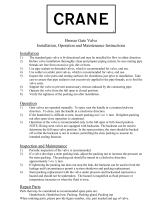
Page 10 of 24
IOM-A114/115 Rev. Rel
a) Upstream pressure and differential pressure conditions at which both opening and closing shall be required. Specify
direction if applicable. Additionally, specify if valve operation is required under high-flow “blow-down” conditions.
b) Speed of operation required or the maximum time for opening and/or closing. Also, specify a minimum time if
required due to fluid dynamics.
c) Electrical power supply available (AC or DC voltage, phase, frequency) for electrical power actuators or controls.
Operating conditions for reduced voltages should also be considered.
d) Pneumatic pressure available for pneumatic actuators (cylinders or diaphragms). Also, specify fail-open, fail-closed,
fail-as-is, or any special requirements.
e) Requirements for position indication signals.
Actuator selection and adjustments should normally be made by Flowserve, SSO, based on published literature and/or
technical advice of the actuator manufacturer. Flowserve, SSO, should be consulted when a manually operated valve must
be retrofitted with a power actuator.
Caution: Some valve actuators, when sized to provide specified loading, may have much higher output at maximum switch
or control settings and therefore be capable of damaging valves if misadjusted. Valve and actuator manufacturers
instructions should be followed closely to prevent overloading valve stems, backseats and other structural parts. Successful
operation of power-operated valves requires a diligent coordination of the skills and efforts of the valve specifier,
Flowserve, SSO, and the actuator manufacturer. Most applications are problem-free, but miscommunication can lead to
unreliable operation at one extreme and possible valve or actuator damage at the other extreme.
Fluid Dynamics of Shut-off Valve Operation
A flowing fluid in a piping system has mass and velocity. Anything that causes a moving mass to change its velocity will
experience a reacting inertia force in proportion to the magnitude of the mass and the rate of the imposed velocity change.
However, in the flow of gases the reacting inertia forces are inherently moderated by the compressibility of the fluid that
permits the instantaneous velocity change to be effectively limited to the mass of fluid in the immediate vicinity. This, in
addition to the self-cushioning capacity of the fluid column in the upstream pipe, effectively precludes any significant
problem of pressure surge in rapidly closed valves in gaseous fluid piping.
In contrast, the inertia of the fluid column in a liquid pipeline is not so easily overcome. Its relative incompressibility
provides no such cushion or proximity-limiting mechanism. The entire upstream fluid mass is required to be decelerated at
once by the closing valve and the resulting pressure surge may be of sufficient magnitude to cause structural damage.
An additional potential problem can occur downstream from the closing valve. This may be described as fluid column
rupture and involves the inertia of the fluid column carrying it away from the closed valve with the proximate space being
occupied by a bubble of the fluid vapor or, simply, a substantial vacuum. If there is sufficient backpressure in the line, the
fluid column will reverse its velocity and close the void created by the fluid column rupture and causes another pressure
surge when it reaches the valve.
It should be recognized that pressure surge intensity is roughly proportional to the length and velocity of the fluid column
upstream of the closing valve and inversely proportional to the time taken to close the valve. Fluid column rupture and
return surge intensity is proportional to the same condition on the other side of the valve in addition to the backpressure in
that section of piping. Therefore, a slow closing is helpful in limiting the magnitude of the pressure surge phenomena.
In large long distance liquid pipelines it is critically important to evaluate pressure surge possibilities and to establish limits
on the speed of closure of the flow shut-off valves. In operating such valves or setting the speed of operation of power-
actuated valves, design limits on speed of closure should be conscientiously observed.
Rapid closure of a valve in any flowing liquid pipeline can cause a substantial pressure surge that may manifest itself in a
sharp “bang” or possibly a series of “bangs”. This is frequently referred to as water hammer. This phenomenon can occur in






















